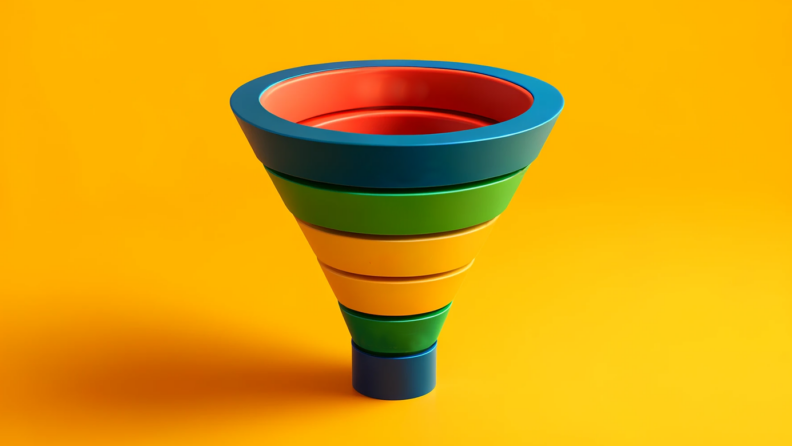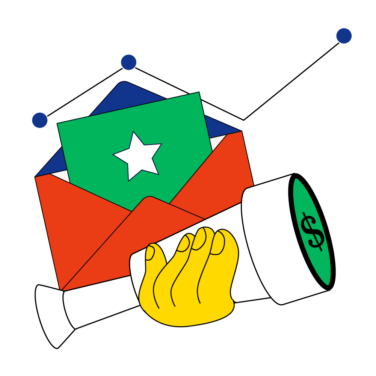Every lost lead, stalled prospect, or delayed deal feels like a missed opportunity to scale in B2B SaaS. But the truth is: without a well-structured sales funnel, you’re not just leaving money on the table—you’re pushing it off the edge.
Ahead, you’ll learn how to create a B2B sales funnel tailored to your SaaS business. We'll cover everything from defining the funnel's stages to ensuring marketing and sales work in perfect harmony to speed up your sales cycle.
Understanding the B2B Sales Funnel

A B2B sales funnel is a visual representation of the customer journey in a business-to-business sales process. It outlines a prospect's stages of buying, from initial awareness of your product to becoming a paying customer. You can use it to map and manage lead generation and progression, ensuring a systematic approach to nurturing and closing deals.
The sales funnel is typically divided into three key stages, but it can be expanded to include a few other sub-stages. More on that below. The primary stages are:
- Top of the Funnel (TOFU): Awareness
Prospects discover your brand through marketing channels like blogs, ads, or social media. The goal here is to spark interest and educate. At this stage, you're laying the foundation—helping them recognize their challenges while positioning your product as a potential solution. - Middle of the Funnel (MOFU): Consideration
Now that they’re intrigued, your leads start digging deeper. This is when they evaluate their problems and explore whether your product fits their needs. Think of this stage as a dialogue—you’re building trust through case studies, webinars, and demos. - Bottom of the Funnel (BOFU): Decision
Prospects are weighing pricing, features, and ROI to decide if your product is worth the investment. This stage involves negotiations, contracts, and closing the deal. It’s your chance to address any last-minute hesitations and emphasize value.
For SaaS businesses, the funnel doesn’t end with the sale. The real value often comes afterward. Retaining customers and ensuring their success is essential for renewals and upsells. Happy customers not only stick around but also drive long-term growth, keeping your funnel thriving with repeat business.
Importance of a Structured Sales Funnel in SaaS
Here’s why having a structured sales funnel is critical for SaaS businesses:
- Streamlines the Lead Journey: Without a clear funnel, leads can fall through the cracks. A structured process ensures each lead moves methodically through awareness, consideration, and decision stages. This clarity prevents lost opportunities and creates consistency in your sales process.
- Enables Targeted Lead Nurturing: SaaS buyers are sophisticated—they expect personalized, timely interactions. A well-defined funnel helps you segment leads based on where they are in their journey, allowing you to deliver targeted, relevant communication that builds trust and drives conversions.
- Aligns Marketing and Sales Teams: Ever felt like marketing and sales are speaking different languages? A structured funnel fixes that by creating a shared framework. It defines when and how leads transition between teams, aligns goals, and ensures everyone is working toward the same outcome.
- Shortens the Sales Cycle: In SaaS, a long sales cycle can stifle growth. A structured funnel helps you pinpoint bottlenecks and inefficiencies, giving you the tools to accelerate the process. The result? Faster deal closures and a healthier bottom line.
- Provides Actionable Insights: A structured funnel offers clarity on performance at every stage. Lead generation metrics like conversion rates, pipeline velocity, and drop-off points help you refine strategies and make data-driven decisions.
Stages of a B2B Sales Funnel
1. Awareness
The Awareness Stage is the first point of contact between a prospect and your business. At this stage, potential customers recognize they have a problem and are seeking solutions, often encountering your brand through marketing efforts.
Goal: Educate your audience and position your SaaS product as a potential solution.
Key Activities:
- Publish blog posts, eBooks, or videos addressing common industry pain points.
- Use targeted ads on platforms like LinkedIn or Google to increase visibility.
- Ensure your website ranks for relevant search terms prospects are using.
2. Interest
In the Interest Stage, prospects move from simply being aware of your brand to actively showing curiosity about your offerings. This is where nurturing begins, helping prospects better understand how your product aligns with their needs.
Goal: Capture leads and establish trust, encouraging further engagement.
Key Activities:
- Offer valuable resources like whitepapers, webinars, or tools in exchange for contact information.
- Send targeted emails introducing your product’s features and benefits.
- Share case studies, testimonials, or user success stories to build credibility.
3. Evaluation
The Evaluation Stage is where prospects dive deeper into your product’s capabilities. They’re comparing your solution to competitors, analyzing ROI, and evaluating how well your product solves their specific problems.
Goal: Position your SaaS product as the best fit for their needs and demonstrate measurable value.
Key Activities:
- Offer live or recorded demos showcasing your product’s features in action.
- Highlight your unique value proposition (UVP) and key differentiators.
- Engage with prospects through one-on-one calls to address questions and objections.
4. Decision Stage
In the Decision Stage, prospects are narrowing their options and seriously considering your SaaS product as a solution to their problem. However, they may still have objections or uncertainties, such as pricing concerns, implementation challenges, or ROI doubts.
Goal: Create a sense of confidence and urgency that moves the prospect from consideration to commitment.
Key Activities:
- Create tailored offers or pricing packages that align with the prospect’s budget and goals.
- Offer a trial period to help prospects experience the product firsthand.
- Provide detailed ROI breakdowns to solidify the value of your SaaS product.
5. Purchase
The Purchase Stage marks the transition from prospect to customer. This is where contracts are signed, payments are processed, and onboarding begins.
Goal: Deliver a positive purchasing experience to build a strong foundation for long-term relationships.
Key Activities:
- Provide clear instructions, training sessions, or resources to help new customers get started quickly.
- Assign dedicated success managers to guide the customer through implementation.
- Confirm satisfaction post-purchase to reinforce trust.
6. Retention & Renewal
The Retention and Renewal Stage is where you transform customers into advocates and maximize their customer lifetime value (LTV). This stage involves keeping customers engaged, ensuring they’re realizing your product's value, and minimizing churn by making sure they renew or expand their contract year after year. This is more important than ever in today's market focus on profitability.
Goal: Maximize customer lifetime value by nurturing loyalty and reducing churn.
Key Activities:
- Ensure customers can easily access help through chat, email, or dedicated support teams.
- Identify opportunities to offer complementary features or higher-tier plans.
- Collect feedback through surveys or interviews to continuously improve your product.
Steps to Build an Effective B2B Sales Funnel
Now to the fun part! Follow these steps to build a B2B sales funnel that works for your team and customers:
Step 1: Define Your Ideal Customer Profile (ICP)
Analyze your existing customers—who are your most successful and satisfied clients? Look for patterns in their industries, company sizes, locations, and challenges. Combine this with market research to identify trends and gaps where your product shines.
Once you’ve collected this data, document your ICP with clear attributes, such as “mid-sized SaaS companies in the e-commerce sector struggling with customer churn.”
Revisit and validate this profile regularly based on performance and customer feedback. A well-defined ICP will anchor all your funnel strategies and help you attract leads that are more likely to convert.
Step 2: Align Marketing and Sales Teams
Your sales funnel can’t succeed if your marketing and sales teams are playing different games. So, start by creating shared goals, like revenue or conversion targets, and ensure both teams understand their role in hitting those numbers.
Define a smooth lead handoff process. For example, agree on what makes a lead “marketing qualified” (MQL) and when it’s ready to transition to sales as a “sales qualified lead” (SQL). Use Service Level Agreements (SLAs) to clarify expectations, and invest in regular team syncs to tackle bottlenecks and fine-tune strategies.
Lastly, invest in shared tools like CRMs to give both teams visibility into the entire customer journey. These are a few of my favorites on the market right now:
Step 3: Develop a Lead Generation Strategy
Filling the top of your funnel starts with attracting the right leads—and that means meeting your ICP where they’re already spending their time. Pinpoint the channels your audience gravitates toward. If you’re targeting enterprise SaaS companies, LinkedIn or industry-specific conferences might be the most effective.
You should also create high-value content like whitepapers, webinars, and case studies that address their pain points head-on. Optimize your website for search engines so you’re easy to find. And don’t overlook outbound tactics: personalized emails and account-based marketing (ABM) campaigns can zero in on key decision-makers.
By combining inbound and outbound efforts, you’ll create a steady stream of qualified leads for your sales funnel.
Step 4: Implement Lead Nurturing Tactics
Once leads are in your funnel, nurturing them effectively is key to moving them toward a purchase.
Segmentation is your starting point here. Group leads based on their interests, engagement levels, and stage in the funnel. Then, deliver personalized content that resonates with their specific challenges and needs.
Note that automation can make the lead nurturing process seamless. Use tools to send drip email campaigns that provide educational resources or product tutorials over time. You can also engage directly with high-value prospects through live demos or consultations. Keep an eye on engagement metrics to see what’s resonating and tweak your approach accordingly.
Step 5: Utilize CRM and Sales Funnel Tools
Managing a B2B sales funnel without the right tools is like flying blind. The right sales funnel tools don’t just make life easier—they make your sales funnel smarter and more effective.
A robust CRM system, for instance, lets you track leads, monitor interactions, and manage pipelines. Pair this with marketing automation tools to handle repetitive tasks like lead scoring and follow-ups.
Integration is key—connect your systems to streamline workflows and ensure no lead falls through the cracks. Use dashboards and analytics to monitor funnel performance in real-time, identifying bottlenecks and fine-tuning your strategy as needed.
Step 6: Measure and Optimize Funnel Performance
Your sales funnel isn’t a set-it-and-forget-it operation. Continuous improvement is the name of the game. Start by tracking key performance indicators that reflect your goals, like conversion rates or time-to-close metrics. You must also review your funnel data regularly to pinpoint where leads drop off or stall.
When you notice a bottleneck, dig into the “why.” For instance, if leads aren’t moving from MQL to SQL, your handoff process might need adjustment. Test new strategies, such as improving your content, streamlining your sales process, or revising your lead scoring criteria. Don’t shy away from feedback, either; your sales team and prospects can reveal blind spots you might miss.
Common Challenges and How to Overcome Them
Handling Extended Sales Cycles
B2B deals often take time due to multiple stakeholders and thorough evaluations, which can strain resources and delay growth.
How to Overcome It: Break the process into bite-sized milestones to keep momentum alive. Provide decision-makers with personalized ROI insights and success stories that directly tackle their concerns. CRMs are also handy in tracking every interaction and automating follow-ups so nothing slips through the cracks. Offer time-limited discounts or exclusive bonuses to create urgency, which can nudge prospects toward faster decisions.
Improving Lead Qualification Processes
Focusing on unqualified leads wastes time and clogs your funnel with unlikely prospects.
How to Overcome It: Use a lead scoring system based on criteria like decision-making authority and company fit. Collaborate with marketing to clearly define MQL and SQL standards so only strong leads move forward. Don't forget to update your scoring system regularly using CRM data to improve accuracy and efficiency.
Ensuring Consistent Communication
Mixed messaging or siloed teams create a fractured customer experience—one that confuses prospects and derails deals. Without aligned communication, opportunities can easily slip through the cracks.
How to Overcome It: Hold regular cross-team meetings and use shared tools like CRMs to stay aligned. Develop clear, consistent messaging everyone follows, and automate follow-ups to maintain steady contact. Personalize your communication to build trust and keep prospects moving forward.
Build Your Sales Funnel
A powerful sales funnel can be the difference between stagnation and accelerated B2B success. If your current funnel isn’t delivering the results you need, don’t wait. Take a fresh look at your process, identify gaps, and start implementing the strategies we’ve outlined.
Need help finding the right software?
We can help! We’ll pair you with an advisor who can find the right tool for your business.


